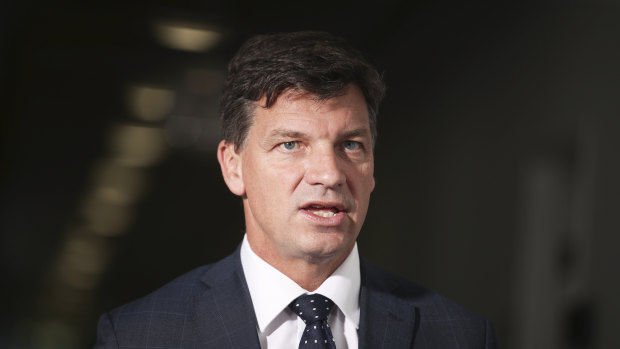By David Crowe
A sharp slowdown in the use of transport during the pandemic has helped cut the nation’s carbon emissions to their lowest levels in three decades, as the Morrison government rejects calls to mandate deeper cuts by 2050.
Transport emissions fell to 19.2 million tonnes in the three months to the end of June as the coronavirus crisis grounded flights, closed workplaces and restricted movement.

Energy Minister Angus Taylor says the government can “meet and beat” its emissions targets commitments.Credit: Alex Ellinghausen
But the federal government’s latest figures also show a slight rebound in industrial emissions since March after a fall earlier this year, revealing the sudden changes in economic activity and greenhouse gas output through the pandemic.
The official figures showed emissions fell to 513.4 million tonnes in the year to June, down from 529.5 million the previous year, an annual fall of 3 per cent and the lowest level since 1998.
Energy Minister Angus Taylor will release the report on Monday with a claim the results prove the government can “meet and beat” its commitments as the results are ahead of earlier forecasts for 2020.
In a statement, Mr Taylor said the figures showed the government would beat its 2020 target by 459 million tonnes and would also beat its 2030 target, set at the Paris climate change talks.
While the 459 million figure includes “carry-over credits” from previous periods – an approach criticised by climate change activists – the report shows Australia is ahead of the 2020 target by 316 million tonnes without relying on those credits.
The biggest change over the past year came in the three months to the end of June, when emissions fell to 122.7 million tonnes compared to 129 million in the March quarter.
Most of that fall came from a decline in transport emissions to 19 million tonnes from 24.2 million in the March quarter.
“This decline in transport emissions was partly the result of a 7.9 per cent annual decline in petrol consumption associated with the impacts of the COVID pandemic,” says the quarterly report from the Department of Industry, Science, Energy and Resources.
Transport emissions include passenger and commercial vehicles, domestic aviation, coastal shipping, diesel rail transport and the transmission of natural gas.
Electricity sector emissions declined 4.3 per cent over the year including a fall to 41.7 million tonnes in the June quarter compared to 44.2 million tonnes in the March quarter.
Industrial processes, however, rose to 8.7 million tonnes in the three months to June compared to 8 million in the preceding quarter.
The director of the Centre for Climate and Energy Policy at the Australian National University, Frank Jotzo, forecast the fall from the pandemic earlier this year but said the shift to renewable electricity was more important over time.
“COVID-19 restrictions matter far less to Australia’s power sector emissions this year than the shift away from coal and towards renewables,” Professor Jotzo wrote in May.
The annual greenhouse gas output is 16.6 per cent below the levels of 2005, the baseline year for the Morrison government’s pledge to reduce emissions by 26 to 28 per cent by 2030.
Labor energy spokesman Mark Butler called on the government again in recent days to embrace a “net zero” target for 2050, claiming Australia would be isolated as other countries including the United States set this target.
Finance and Trade Minister Simon Birmingham said on Sunday the government wanted to see net zero emissions “as soon as possible”.
“That could be earlier than 2050. What we have to do is make sure we all have a clear plan on how to get there,” he said.